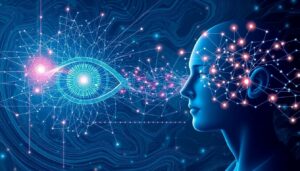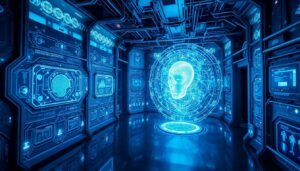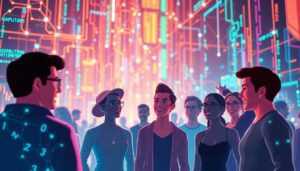No, I am not talking about a new-age utopia in the future where everything is automated. What makes this possible? The solution is computer vision.
Computer vision is a subfield of artificial intelligence (AI). It allows computers to “see” and interpret images and videos. Machine learning is very similar to it. Enabling computers to learn from data without being clearly programmed.
In this article we’ll provide and in-depth knowledge of what is a computer vision. You will learn its uses and future trends.
What is Computer Vision?
Computer vision enables machines to see and make sense of what they view in the world. It’s like giving a computer a set of eyes and a brain to make sense of what those eyes see. Rather than human eyes gazing at images, we have hardware interpreting them. This can be useful!
Walking Through How Computer Vision Works, Step by Step
How Does Computer Vision Work in Brief? Such things assist computers in making sense of images. Here’s a quick look at them:
Image Acquisition: This is when the image or video is captured through one camera or sensor.
Processing: The image is cleaned up and enhanced to remove noise and improve quality
Feature Extraction: Important features such as edges, shapes, and textures are recognized.
Interpretation/Classification: The computer uses these features to understand what it is seeing and classify it.
The Differences between Human Vision and Computer Vision
Computer vision and human vision both enable seeing, but with different strengths. Humans are skilled at interpreting context and managing uncertainty. Computers outperform humans when the task is high-throughput data processing done at a rapid and precise rate.
Humans can detect objects in different lighting easily. Similarly, computers require training on massive amounts of data to accomplish the same task. But a computer is never fatigued. Computers don’t make judgement calls the way people do, either.
Fundamental Terms in Computer Vision
Some frequently used computer vision terminologies are:
Machine Learning Basics: Knowing what the image has Like identifying a cat.
Object Detection — Localizing and identifying objects. This is something like detecting all the cars in a street scene.
Image Segmentation : Partitioning an image into multiple segments or regions
Image Classification: Tagging an image with a single label.
Core Techniques and Algorithms
Different techniques are used to grasp pictures from the computer vision standpoint. These are some of the core techniques:
CNN – Deep Learning Powerhouse
CNN (Convolutional Neural Networks) — The backbone of computer vision. They are particularly adept at image recognition. Convolutional Neural Networks (CNNs) apply layers, filters, and activation functions to learn the features of images. They are able to learn the important features of an image without requiring any formal input.
Detecting Objects: Who is Where?
But … Object detection locates objects on images. Popular algorithms include YOLO, SSD, and the Faster R-CNN. They are fast to find and label things.
YOLO: Fast and efficient.
SSD ⟹ Good for detection in real-time.
Read more (and have limited guidance) on the Faster R-CNN The Faster R-CNN: AProved — 500 images/sAP = mAP Read more (and get little guidance) on the Whether Fast & R CNN Accurate (mAP = 0.022)(Faster) R CNN Slow and Reliable.
Image Segmentation: Understanding at Pixel Level
Image segmentation analyzes each pixel in an image. It puts them into groups. Semantic segmentation means that it groups pixels that represent similar meanings. Instance segmentation finds each single object. That helps machines learn to read images at a very granular level.
Usage of Computer Vision In The Real World
Computer vision is already being applied across industries. Here are a few examples.
Example of Computer Vision | in Healthcare with Medical Imaging
The Future of Computer Vision in Healthcare This aids in tumor detection. It also aids doctors in identifying correct diagnoses. It’s used by surgical robots for enhanced precision.
Driving Into the Future: Computer Vision in Automotive and Autonomous Driving
Computer vision is used in self-driving cars. It aids them in finding lanes, traffic signs and people. Computer vision is what makes driving safer!
Quality Control Automation: Computer Vision in Manufacturing
In manufacturing, computer vision is used for quality control. It finds defects. It also improves robotic assembly and helps predict machine repairs.
Hazards as well as Boundaries of Calculator Vision
All its advancement considered, computer vision has its limitations. Let’s examine some of those.
Diversity in Data: Reducing Data Dependency and Bias
Lots of data is needed for computer vision. That can lead to bad results, if the data isn’t good. Dataset bias should be avoided by ensuring diversity in datasets which we already know.
Training Loss and Computational Requirements
This type of computation is very intensive and capable of powering many computer vision tasks. They require powerful computers and massive energy to perform complex tasks. This can be a challenge.
Robustness and Generalization: Coping with Real-World Variability
Conditions can change, which can baffle computer vision. Different lighting, occlusions, and other factors that occur in real life can be difficult to deal with. There is a need to make the systems more robust.
The Future of Computer Vision
Computer vision is a fast changing space. Here are a few notable trends emerging.
Breakthroughs in Deep Learning Architectures
New deep learning models improve accuracy and efficiency The researchers are always finding new ways to make these algorithms efficient.
Real-Time Processing and Edge Computing
It is becoming popular to run computer vision models on devices ( edge computing). This helps in faster processing without transmitting data to the cloud.
Responsible AI and Ethical Considerations
There are ethical implications of computer vision that needs to be considered. It’s critically important to ensure AI is developed responsibly. We should address elements like biases and privacy concerns.
Conclusion
This data drives so many of our technological applications and assumptions today — and computer vision is redefining how that data is processed. This technology is constantly growing in various industries. Its influence is profound, from healthcare to automotive. Its potential for affecting our future only becomes clearer as it evolves. Computer vision the future — a more intelligent, automated world.



